By David Kronke
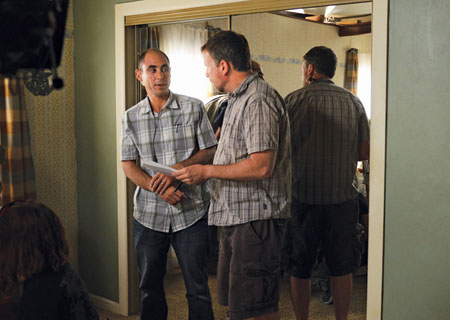 1st AD Benjamin Scissors (left), with 2nd AD Louis Lanni, makes sure the director understands the
1st AD Benjamin Scissors (left), with 2nd AD Louis Lanni, makes sure the director understands the
visual style of the show. (Photo: Sony Pictures Television/Ursula Coyote)
Breaking Bad is a series all about better living through chemistry. Not the chemistry that creates the pure yet deadly crystal meth cooked up by the show’s anti-heroes, but the chemistry between the directors and the directorial team that assists them in maintaining the show’s distinctive visual style, intensity, and darkly comic tone.
Twenty-two directors have directed the 46 episodes of Breaking Bad’s first four seasons, with 20 having helmed four or less. Which means the ADs have a lot on their plates in terms of prepping incoming directors on the particulars of replicating the show’s idiosyncratic look. New directors have to know about the show’s heavy dependency on wide lenses used to capture the severe beauty of the desert surrounding Albuquerque, New Mexico; the long, single takes used to build tension to the breaking point; and the propulsively-edited action sequences that bring everything to a boil.
Consider the cool presence of Nina Jack, one of the show’s two 1st ADs. On an arid June morning in Albuquerque, she’s on location at a local airport set, making sure that everyone on the crew is on the same page and that the background actors are getting their prop luggage. Once that three-scene sequence is shot, she’s quickly off multitasking at another location. While the crew sets up a crane shot for the next scene, Jack is discussing with prop masters and cinematographer Michael Slovis how to best carve up a vintage Ford Crown Victoria for a sequence that won’t be shot until next week. (They decide to cut off the back windshield and remove the trunk lid in order to install camera mounts.)
“Since the crane shot required some setup time and we were in the process of a company move and still waiting on some equipment,” explains Jack, “I decided that while we waited, we would take a look at the car. As much as possible, I try to use the time on set when we are not shooting to do this sort of prep work.”
Juggling such disparate information would be daunting and even disorienting for many, but for Jack, it’s the norm. “It’s just the strange way my brain works—I probably found the ideal job for me,” she says drolly. “Something I was taught as a trainee and never forgot was to always be asking: ‘Why aren’t we shooting right now?’ and then do what I can to get to where we can be shooting. These questions are what I am constantly asking and answering, and that guides me through each scene.”
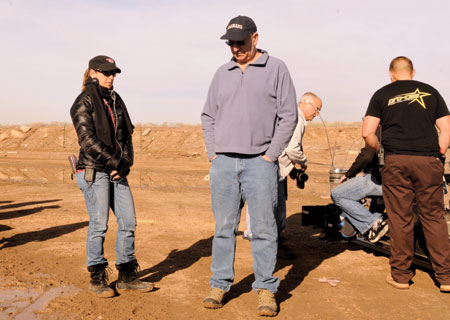 1st AD Nina Jack, with DP Michael Slovis, arranges the schedule to accommodate multiple moves,
1st AD Nina Jack, with DP Michael Slovis, arranges the schedule to accommodate multiple moves,
including frequent trips to the desert. (Photo: Sony Pictures Television/Ursula Coyote)
Like many episodic shows, Breaking Bad alternates 1st ADs. While Jack works one episode, Benjamin Scissors is prepping the next. At the same time, the rest of the directorial team, including 2nd ADs Joann Connolly, Louis Lanni, and 2nd 2nd Anna Ramey, are doing their part. “Because we alternate shows, it allows me to be focused on this episode,” says Jack. “The DP, the producers, everyone else has their head in all the episodes, so I know what has to be dealt with right here. I also think in more selfish terms—what’s going to make our day go as easily as possible. When we show up, I want everyone prepared for every single shot.”
On a rare moment when she’s not in motion, Jack reflects on her responsibilities. “I’ve heard my job described as the manager, the organizer, the quarterback, the bus driver, the announcer, and the den mother. But basically I am in charge of the set, how it runs and moves and flows, all in the safest, most efficient and enjoyable way possible. Cast, crew, extras, logistics, elements, schedule—they all fall under what I am in charge of in some form. But the ultimate purpose and motivation of how I run the set is fueled by assisting the directors to be able to envision and execute their design and vision for the story to be told, all within the show’s budget and timeline.”
And there’s one more thing that you won’t find in textbooks: “I also try to make sure the director is eating, hydrating and smiling,” Jack adds. “It sounds small, but a happy, fed director helps ensure a smoother day on set.”
While Jack is on the set working on the current episode, Scissors is prepping director/producer Michelle MacLaren for one of the action-heavy episodes she specializes in. Directors on the show get seven days of prep time, one day more than the DGA’s contractual requirements. It’s time well spent, says Scissors. “The amount of prep time between the director and 1st AD on Breaking Bad is somewhat unique. It hasn’t been that intensive on other shows, in my experience. Here, we’re linked at the hip 11 or 12 hours a day. We’re in meetings, we’re casting guest roles, and we’ve got a day to visit locations.
“A lot of bonding goes on in that scout van as we find all the places to shoot and are working out the details,” continues Scissors. “I put the director up front so he can really see Albuquerque. I’m putting out questions, getting him to think about how he wants his episode to look.”
How the episode looks is key for a show as visual as Breaking Bad. “This is a creative environment,” MacLaren says. “We don’t put the demands of conventional television on [our directors], we want them to tell the story the best way they can. We’re a very graphic show, and for a director, that’s really fun. We like the show to be shot like a feature. We have certain directors who come in and don’t like wide lenses; they like long lenses and their shows look great.” But she adds, parenthetically, “We do encourage them to work in a couple of wide lenses.”
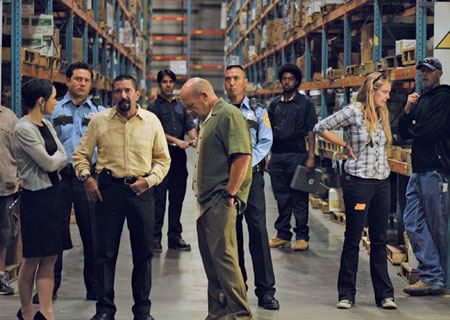 ON LOCATION: 2nd 2nd AD Anna Ramey (right), working with cast members in a warehouse,
ON LOCATION: 2nd 2nd AD Anna Ramey (right), working with cast members in a warehouse,
says “setting background is one of the more fun and creative things I get to do.”
(Photos: Sony Pictures Television/Ursula Coyote)
Ensuring that the director understands the visual style of the show is perhaps the ADs’ most crucial job. “When a new director comes in, there’s a lot of catching up to do because it’s a very stylized show,” notes Scissors. “The most important thing for the guest director is merging the director’s vision with the language of the show. We don’t shoot a lot of coverage—we don’t have that much time. We don’t need five looks on an actor. The biggest thing for an experienced director is that it’s a bit of a change in mindset.”
“The challenge in doing Breaking Bad is that the show has changed, the characters have changed, and as a result, we had to change,” says UPM (and occasional 2nd unit director) Stewart Lyons. “My job’s just gotten bigger and more intense.”
Indeed, executive producer, writer, and sometime director (including the pilot) Vince Gilligan conceived Breaking Bad as charting the downward moral spiral of its central character, Walter White (Bryan Cranston), as he evolved from a sad-sack high school chemistry teacher into a brutal drug lord. As a result, the show has evolved from spending a lot of time on standing sets to spending six or seven of its eight production days on location, as Walter is often desperately on the run from those pursuing him. “
We would like to shoot on soundstages more than we do—it adds tens of thousands of dollars a day to the budget when we move—but we naturally see ourselves out and about in Albuquerque,” says Gilligan. “On a soundstage, you just flick on the lights; you know where the bathrooms are. Locations add a lot of logistical knots to be untied and makes life in general tougher for the ADs and crew. You have to move every single item, down to the last roll of gaffer tape, with you through the deserts of New Mexico.”
“Locations are a very big part of the show,” agrees Scissors. “We want to see Albuquerque, so we’re always winding up someplace new and there are inherent challenges with every location. It’s not uncommon to be in the city one day and the desert the next. Fortunately, it’s Albuquerque and nothing is too far away. It’s just a matter of proper organization and communication with all the departments. The crew has gotten better at moving. We take out lighter packages and we have a smaller footprint because we know we’re going to so many locations.”
Jack is mindful of the challenges filming at multiple locations in a single day when she carefully arranges the production’s shooting schedule. “I like to start with something small, to get the company going,” she says, “then get to the meat, the big stuff. And then, if you had to shorten something, if you could lose it, put that at the end of the day.”
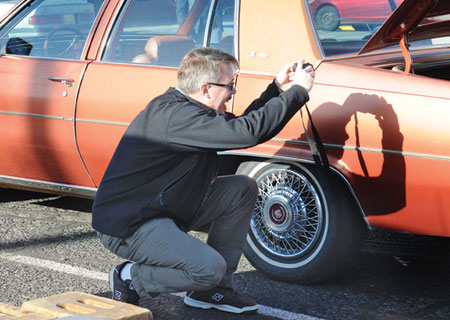 PIECES OF THE PUZZLE: The show’s creator Vince Gilligan.
PIECES OF THE PUZZLE: The show’s creator Vince Gilligan.
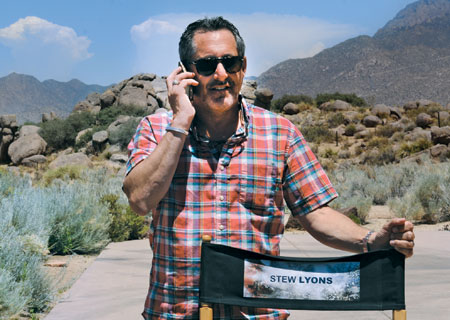 UPM Stewart Lyons.
UPM Stewart Lyons.
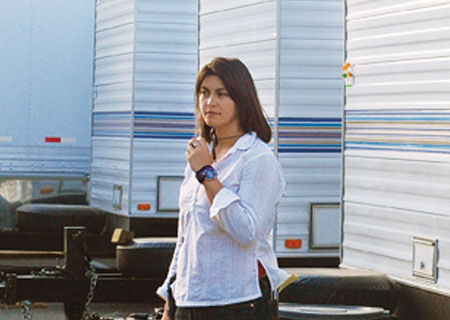 2nd AD Joann Connolly. (Photos: Sony Pictures Television/Ursula Coyote)
2nd AD Joann Connolly. (Photos: Sony Pictures Television/Ursula Coyote)
Desert shoots present particular challenges. “It’s hard to get equipment in certain spots,” notes Scissors. “We’ve had to build our own roads. And hiding equipment in the desert can be a problem, since we’re shooting things from 360 degrees and the locations can be totally flat. We’ve built little shacks to hide the equipment.”
Slovis, DP since season two (and occasional director), recognizes the contribution of the directorial team from another perspective. “The assistant directors are really pivotal to the success of not only the aesthetics and the performances of the show, but the logistics of the show, in making it happen on time. The first person a director works with is the AD, and that AD has the unenviable job of jockeying talent schedules, making sure that the cast can get to ADR for the previous show but also be on the set. It’s daunting, and every single episode seems impossible and yet every single episode somehow gets done. The ADs are very often the first hires that a producer makes because they see them as the success of the show.”
Gilligan also applauds the work of the directorial team. “The show couldn’t have two better ADs,” he says. “A really good AD is someone who, like the TV commercial says, you never see them sweat. You don’t even see what they’re doing. There’s no yelling. They’re the serene calm in the midst of all sorts of frustrations and logistical problems. They keep the train rolling.”
MacLaren, who says Jack and Scissors “probably save us every day,” recalls some of the ADs’ above-and-beyond moments. Jack’s came in the fifth episode of the current season.
“That episode was one of the biggest logistical challenges I’ve ever seen,” MacLaren says. “We had more than one unit shooting simultaneously. Jack showed up in the morning and had this incredible breakdown showing which unit was going where and what they were doing. She put the director’s shot list together in a tactical way. At one point, I was directing one of the other units, and the main unit couldn’t get the visual effects shot. So she simply moved equipment from one unit to another and production proceeded apace.”
Claiming it was no big deal, Jacks explained how she did it. “We were doing the equivalent of a huge action film in about four days and on a television budget,” she says of the episode. “It’s really about breaking everything down into pieces, and understanding what’s the most important thing in each scene, where’s the heart of the story and how the director wants to tell it. Once I know what’s important in the shot, I can design the schedule so that we’re doing it the best we can.”
One of Scissors’ shining moments came in season four, when MacLaren was directing a sequence that had Walter White racing his dilapidated Pontiac Aztec through the streets of Albuquerque. “We only had so many hours of daylight,” she says. “It’s a challenge when you’re shooting with car mounts and rigs and camera vehicles. We had a three-block industrial area that we locked up. We had three [different versions of the Aztec]. Ben had a plan that when we were shooting one car, the grips were getting the next car ready. At the end of the day, we got everything we wanted. Usually, you come with your plan and then you throw your plan out the window and hope for the best. But Ben ran it like a military operation.”
Like Jack, Scissors takes a blasé, just-doing-my-job attitude in recalling the moment. “It was our Fast and Furious sequence, Breaking Bad-style,” he jokes. “It wasn’t that fast; it wasn’t very furious. It was just getting all the pieces organized ahead of time so you can leapfrog from one scenario to another. It’s great to have all those toys, but it can bog you down. Any time you can go from one piece of equipment onto another and not have the camera wait is huge on a day when every moment of daylight counts.
“People have done car chase scenes forever,” continues Scissors. “There’s a certain type of language you expect to see and certain shots you expect. We did some of those but we also tried to bring something to the screen people aren’t used to seeing. The mounting of the cameras onto vehicles was a very intricate dance that day. We were going from one camera to another and getting them on the proper cars—film cameras on the outside of vehicles and digital cameras inside cars. In the end, we had more shots than we could hope to have done in the amount of time we had.”
Scissors recalls an even more challenging scene of auto-related mayhem, a sequence in which Walt went to a remote parking lot and performed a wild series of spinouts and doughnuts in a car that his wife demanded he return to the dealership. He torches the car, resulting in an explosion sending fireballs leaping into the sky.
“We had to shoot the explosion first for safety reasons,” Scissors points out. “The Albuquerque winds were increasing throughout the day and we had to pre-load the car with explosives for time efficiency. So the whole thing was shot out of sequence in mapped-out sections of the parking lot.”
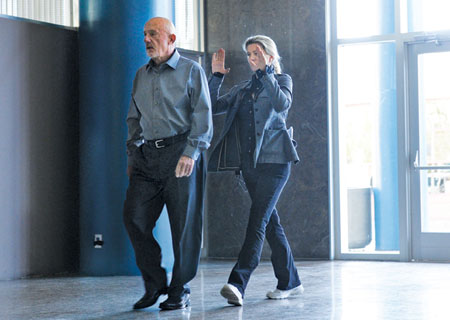 Director/executive producer Michelle MacLaren lines up a shot with actor Jonathan Banks.
Director/executive producer Michelle MacLaren lines up a shot with actor Jonathan Banks.
(Photo: Sony Pictures Television/Ursula Coyote)
While all the big, explosive action is going on, the 2nd ADs are doing their thing. MacLaren says they make important contributions that are evident onscreen. “They’re very good at handling background, which is very hard to do,” she says. “I love it when I’m directing and you’ll have 100 people on the set and you see they have something going on in the corner and it adds that little something to the story. The second [ADs] are thinking about it; they look through the lens and the monitor and realize what we need and where. As a director, I appreciate that they contribute to creating an environment.”
2nd 2nd AD Anna Ramey enjoys that part of the job. “Setting background is one of the more fun and creative things I get to do, especially for a show like Breaking Bad that cares. We’ve done things like mass parties where we have to make them look as raunchy and interesting as you want television to be, but also realistic and give these meth-high characters things to do, which is very cool.” Ramey laughs that she didn’t do any research into meth parties, “but it seemed a lot of our background had.”
There hasn’t been as much intricate extras work in season five, Ramey reports, but one scene she enjoyed choreographing involved the introduction of a new character to the show. “The character was walking through this huge office space and we had to find a way for the extras to move not in a way that isolated the character but allowed the character to pop,” she explains. “The idea was that no one is taking notice of them but maybe someone should. That’s where you interact with the director—how involved do they want the extras to be? Some directors want them to react [to foreground action] and some don’t, and that’s one of the arts of setting background.”
It’s often the little things 2nd Ads do that can have the most impact. Joann Connolly remembers the time she helped save an episode. A German woman had been cast in a supporting role, but Connolly discovered that the woman didn’t have the appropriate papers to work in the U.S. So Connolly helped rush a replacement actress through costuming in the course of a few hours. “Even the details of paperwork matter,” she says with a smile.
An unsolicited testimony to the directorial team comes from one of the crusty cast members, Jonathan Banks, who plays the ruthless fixer Mike on the show. “In my 45 years in the business, Nina Jack is hands down the best AD I’ve ever seen, and I’m not the only one who thinks that,” he declares without being prompted. “Not only does she keep everything moving, but she does it in the most deft and pleasant way. And Ben Scissors has taken many cues from her and he’s a pleasure to work with, too. I’m a cranky old bastard, but what I say about them is heartfelt.”
Good chemistry, indeed.